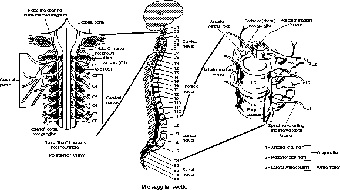Anatomy and Physiology: Spinal Cord and Peripheral Nerves
Spinal Cord and Peripheral Nerves
A look at the spinal cord, our bridge to the PNS, shows that the sensory and motor tracts occupy areas of the cord. Remember the posterior and anterior gray horns? Well the sensory information travels through the posterior gray horn. This gray horn is further divided into somatic sensory, which receives information from the muscles and skin, and visceral sensory, which receives information from the internal viscera. This gray horn contains sensory cell bodies not found in the dorsal root ganglia. There are three pathways for sensory information, from the ventral ramus and dorsal ramus (ramus = branch, plural = rami) of the spinal nerve, or from the sympathetic nerve. As part of the posterior gray horn, it makes sense that sensory information travels through the posterior root, regardless of its source.
Think about the sensory nerves, which have dendrites from the receptors, and axons up to the brain. The cell bodies, which are, of course, wider than the dendrites and axons, need to go somewhere! The ganglia are just the place to keep them! Sensory nerve cell bodies go in the dorsal root ganglia, and motor nerve cell bodies go in the sympathetic ganglia, which sit anterior to the ventral root, but branch off of the spinal nerve itself. (See the section on the sympathetic and parasympathetic branches of the ANS later in this section.) Other cell bodies can be found in the gray horns of the spinal cord. (See the sensory and motor sections later in this section.) In addition to each of these series of ganglia, there are some larger ganglia that form part of the sympathetic branch: the celiac ganglion, the superior mesenteric ganglion, and the inferior mesenteric ganglion.
Flex Your Muscles
The names for the parts of a nerve are analogous to the names for parts of a muscle. If you can remember epimysium (see The Structure of the Muscles and Muscle Cells), then you will know what the epineurium is (the fascia around the nerve). All the nerve parts have equivalent muscle parts; they even both have fascicles!
The structure of a nerve is similar to the structure of a muscle. For example, the fascia(connective tissue; see The Structure of the Muscles and Muscle Cells) around the nerve is called epineurium (like the epimy-sium). Around each bundle of nerve fibers (neurons) called fascicles (so named because theyare little bundles wrapped in fascia), the fascia is called perineurium. There is even anendoneurium around each neuron, which acts as an extra layer of protection, even in thepresence of Schwann cells (see The Nervous System).
Just as there are 12 pairs of cranial nerves that attach to the brainstem, attached to thespinal cord there are four sets of peripheral nerves: 8 pairs of cervical nerves, 12 pairs ofthoracic nerves, 5 pairs of lumbar nerves, and 5 pairs of sacral nerves (see Figure 20.9).These are easy to remember if you think about the divisions of the spine.
A typical college level text will explore the various functions of the spinal nerves as well as the plexuses, which are braids of nerves that control various functions. This is also true interms of the muscles, in terms of the nerves that innervate them. In general, the moremuscles controlled by nerves, the wider the spinal cord in that region. Since the arms arecontrolled by cervical nerves, and the legs are controlled by the lumbar and sacral nerves,the thoracic nerves have little to do, hence the narrowness of the thoracic spinal cord.

Figure 20.9The spinal nerves, with a detailed view of the cervical nerves, and a close up of the pathways leaving the lumbarvertebrae. (LifeART©1989-2001, Lippincott Williams & Wilkins)

Excerpted from The Complete Idiot's Guide to Anatomy and Physiology © 2004 by Michael J. Vieira Lazaroff. All rights reserved including the right of reproduction in whole or in part in any form. Used by arrangement with Alpha Books, a member of Penguin Group (USA) Inc.
To order this book direct from the publisher, visit the Penguin USA website or call 1-800-253-6476. You can also purchase this book at Amazon.com and Barnes & Noble.
